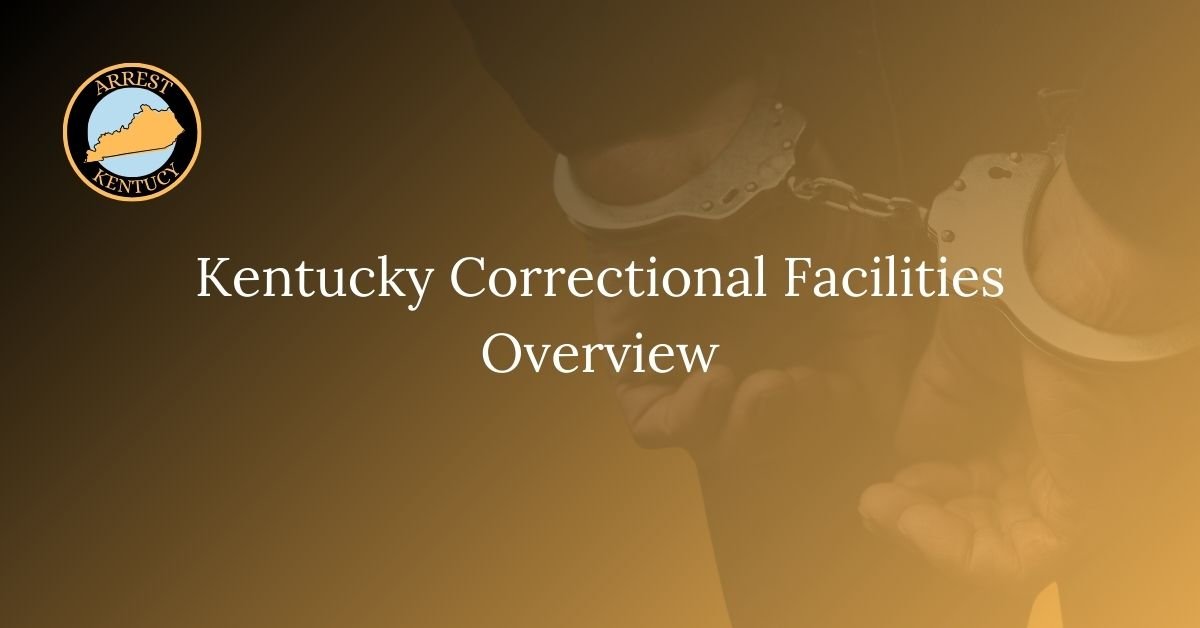Kentucky Correctional Facilities Overview

Kentucky’s approach to managing its prison system is central to its commitment to public safety and justice. The state operates a network of correctional facilities designed to address a wide range of security needs and accommodate inmates with varying levels of risk. Each facility is equipped to handle specific types of offenders, ensuring that those who have broken the law are appropriately managed and provided with essential services. This structured system aims to maintain order, support rehabilitation, and contribute to the community’s overall safety.
This detailed overview will explore Kentucky’s prison facilities, highlighting the different types of institutions, the amenities and services available, and the privileges granted to inmates. Whether you are a concerned citizen seeking to understand the inner workings of these facilities or simply interested in the state’s correctional practices, this guide offers valuable insights into how Kentucky manages its incarcerated population and supports its rehabilitation efforts.
Security Levels of Prisons
In Kentucky, the prison system is structured to address different levels of security needs. The state operates several types of facilities, each designated to manage inmates based on the severity of their offenses and their security risk. Low-security prisons, often referred to as minimum-security facilities, house inmates who have committed less severe crimes and who present lower security risks. These facilities typically offer a less restrictive environment. On the other end of the spectrum are high-security prisons, designed to house individuals convicted of serious crimes and deemed high-risk. These institutions are equipped with stringent security measures to prevent escapes and manage the behavior of dangerous offenders. The varied levels of security ensure that each inmate is housed in an environment that matches their specific needs, which helps maintain order and safety within the correctional system.
High-Risk Institutions
Some prisons in Kentucky are specialized to handle inmates with complex and challenging needs. These high-risk institutions are designed to manage individuals with significant behavioral issues or those who pose a higher security threat. The role of these facilities is critical in addressing the unique challenges presented by such inmates, including those with violent tendencies or severe psychological conditions. These institutions are equipped with specialized staff and security measures to handle the complexities associated with managing high-risk offenders. The goal is not only to maintain security and order but also to provide appropriate care and management tailored to the specific needs of these individuals.
Basic Inmate Provisions
In all Kentucky correctional facilities, the state ensures that inmates are provided with essential necessities. These include basic items such as bedding, food, and drink, which are crucial for maintaining the health and well-being of the inmates. Regardless of the nature of their crimes, all inmates are entitled to these fundamental provisions. The state has established protocols to guarantee that these necessities are consistently available, which helps in creating a minimum standard of living within the prisons. This approach is part of Kentucky’s broader commitment to ensuring humane treatment for all incarcerated individuals, reflecting the principle that while inmates are serving their sentences, their basic needs must be met.
Educational Opportunities
Education is a key component of the rehabilitation process for inmates in Kentucky prisons. The state offers a range of educational programs aimed at fostering personal growth and preparing inmates for reintegration into society. These programs include formal education such as General Educational Development (GED) courses and vocational training that equips inmates with practical skills. Additionally, some facilities provide access to college courses, which can further enhance an inmate’s qualifications and job prospects upon release. By supporting educational initiatives, Kentucky’s prison system aims to reduce recidivism rates and improve the chances of successful reintegration for inmates, ultimately contributing to their personal development and future success.
Family Communication
Maintaining connections with family and friends is vital for the mental and emotional health of inmates. Kentucky’s correctional facilities recognize this need and facilitate communication between inmates and their loved ones through various means. Inmates are allowed to make telephone calls, participate in visitations, and engage in video calls, all subject to specific rules designed to ensure safety and security. These communication opportunities help inmates stay connected with their support networks, which can provide emotional support and maintain family bonds. The ability to communicate with family members is an important aspect of an inmate’s well-being and can positively influence their behavior and outlook during their incarceration.
Work and Commissary Programs
Inmate work programs are an integral part of the correctional system in Kentucky. These programs provide inmates with vocational training and the opportunity to earn a small wage for their work. Participation in these programs helps inmates develop valuable job skills and fosters a sense of responsibility and work ethic. Earnings from work programs can be used to purchase items from the prison commissary, which offers various goods that enhance comfort and personal well-being. The commissary system allows inmates to access additional items that might not be provided by the prison, contributing to their overall quality of life during incarceration. These programs also serve as a form of rehabilitation, preparing inmates for successful reentry into society.
Recreational Facilities
Prison life can often be monotonous and restrictive, which is why recreational facilities play an important role in maintaining inmate morale and well-being. Kentucky’s prisons are equipped with dayrooms and recreational areas where inmates can engage in leisure activities and interact with others. These spaces are designed to provide a break from the daily routine and offer opportunities for relaxation and socialization. Access to recreational activities helps alleviate some of the stresses associated with incarceration and supports a healthier psychological state. The availability of such facilities contributes to a more balanced and manageable prison experience, allowing inmates to maintain a degree of normalcy and engage in positive social interactions.
Behavior-Based Privileges
In Kentucky’s prisons, privileges are assigned based on individual behavior and conduct. The correctional system uses a classification process to determine what privileges an inmate is eligible for. This system evaluates inmates’ behavior and their adherence to prison rules, with those demonstrating good behavior receiving access to more privileges. Privileges can include increased visitation rights, access to recreational facilities, and participation in various programs. The classification review process ensures that privileges are earned through positive conduct, reinforcing the importance of maintaining good behavior while incarcerated. This system helps manage inmate expectations and promotes a more orderly and respectful environment within the facilities.
Matrix Level System
The matrix-level system is a tool used in Kentucky’s prisons to assess inmates’ eligibility for certain privileges. This system takes into account various factors, including behavioral history, achievements, and overall conduct. By evaluating an inmate’s progress and accomplishments, the matrix-level system determines what privileges they may be granted. This approach helps ensure that privileges are awarded based on merit and ongoing behavior, creating an incentive for inmates to engage in positive activities and adhere to facility rules. The system aims to balance security concerns with the need for fair and motivating reward structures for inmates.
Privileges Versus Rights
Inmates in Kentucky prisons are entitled to certain constitutional rights, but these rights are distinct from the privileges granted by the correctional facilities. Rights are guaranteed by law and cannot be arbitrarily denied, whereas privileges are subject to facility-specific rules and can be revoked if an inmate violates regulations. Understanding the difference between rights and privileges is important for inmates and their families. Rights ensure basic protections and humane treatment, while privileges, such as access to additional programs or recreational activities, are contingent upon compliance with prison rules. This distinction clarifies that while inmates have fundamental rights, the additional benefits and freedoms within the facility are earned and can be withdrawn if necessary.
Frequently Asked Questions
For additional details beyond what’s covered in this overview, please refer to the comprehensive FAQs section.
What are Kentucky’s Correctional Facilities?
Kentucky’s correctional facilities are state-operated institutions designed to confine and manage individuals convicted of crimes. These facilities serve multiple purposes, including detention, rehabilitation, and punishment, ensuring that inmates are securely housed and provided with necessary services. Each facility is equipped to handle different security levels and types of inmates, reflecting the state’s comprehensive approach to managing its incarcerated population.
How many correctional facilities are in Kentucky?
As of the most recent information, Kentucky operates a number of correctional facilities spread throughout the state. The exact count of these facilities can vary over time due to changes in the correctional system, including the opening or closing of facilities. The state continually evaluates its correctional infrastructure to address the needs of its inmate population.
What types of inmates are housed?
Kentucky’s correctional facilities accommodate a diverse range of inmates. This includes individuals convicted of both misdemeanor and felony offenses. The facilities are designed to manage various types of offenders, from those committing less severe crimes to those involved in serious criminal activities. The classification of inmates helps ensure that they are housed in appropriate facilities based on their offense and security needs.
How are inmates assigned to facilities?
The assignment of inmates to specific Kentucky correctional facilities is determined by several factors. These include the severity of the inmate’s offense, the length of their sentence, their security classification, and the available space within the facilities. This process helps ensure that inmates are placed in environments that match their needs and risk levels, facilitating better management and security within the prison system.
Can visitors see inmates?
Family members and friends can visit inmates in Kentucky correctional facilities during designated visiting hours. These visits are subject to specific rules and regulations to maintain safety and security within the facilities. Visitors must adhere to guidelines set by the Department of Corrections, which include security screenings and restrictions to ensure that the visitation process is safe and orderly.
What programs are available for inmates?
Kentucky correctional facilities offer a variety of programs designed to support inmate rehabilitation and personal development. These programs include educational courses, vocational training, substance abuse counseling, and mental health services. The goal of these programs is to provide inmates with the tools and support they need to improve their skills and address underlying issues, ultimately aiding in their successful reintegration into society.
How can inmates communicate with others?
Inmates in Kentucky’s correctional facilities can maintain communication with the outside world through approved methods such as letters, phone calls, and video visits. These communication channels are regulated to ensure security and prevent illegal activities. The system is designed to allow inmates to stay connected with their families and support networks while maintaining the safety and integrity of the correctional environment.






